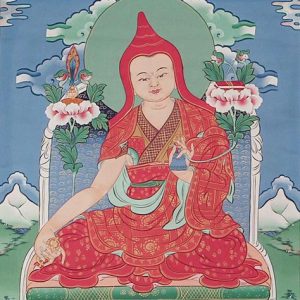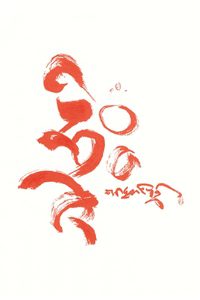Wednesday
Dharma TeachingsGreat Clouds of Blessings 1
Comments on A Supplication for Magnetizing the Phenomenal World
by Russell Rodgers
This is a less well-known optional morning chant that anyone can do. It was written by the great Jamgön Mipham Gyatso 1879. It belongs to a class of practices that are appropriate when special situations arise in the outer world. For instance, members might do it when a Shambhala Centre needs to magnetize resources to make a change.
The Sakyong, the present incarnation of Mipham, comments: “The fundamental purpose of magnetizing is to magnetize your rikpa, your own awareness, for the sake of achieving realization. When we practice this supplication, we should understand that we are magnetizing our lungta, our windhorse, as well as our rikpa. That is the real meaning of magnetizing. Then there is putting magnetizing into action, into enlightened activity, in a relative way. As the Buddha taught in the sutras, a bodhisattva needs to engage in four activities to attract students: generosity, pleasant speech, meaningful action, and consistency of words and actions. Students can then develop more confidence in, and come closer to, the teacher.”
The chant begins: OM AH HUM HRIH Within the magnetizing palace of great bliss….The first three syllables are a kind of salutation invoking the principles of body, speech and mind. HRIH is the seed syllable of some of the deities connected to the transformation of passion. In sadhana practice, one first meditates on emptiness. Then, out of that emptiness, a seed syllable such as HRIH appears. In this case, the seed syllable turns into a palace and, later in the chant, into deities. Emptiness is important here, because otherwise one might think that one is supplicating a deity that has solidified external existence. In the vajrayana, deities are created step by step out of emptiness. They retain aspects of that empty quality as we visualize them, and later, the appearance of the palace and the deities is dissolved into emptiness again at the end of the practice.
In the vajrayana, there are four enlightened actions, known as the four karmas: pacifying, enriching, magnetizing and destroying. This chant is related to the third karma, magnetizing. It highlights the quality in us that is related to how we are drawn to our world, and how we draw the world to us. This kind of magnetizing exists on an energetic, pre-thought level.
As with other vajrayana practices, one invokes energy by first imagining it. In the beginning, that energy can seem artificial and separate. Ultimately, we recognize that these energies are actually native to our being, and always have been. They are part of our lungta, or life force. It’s just that we usually only experience them in solidified form, buried in habitual thought patterns. The challenge posed by this chant is to recognize that energy in its pure form.
 One word that happens repeatedly in this chant, beginning with the first line, is bliss. Bliss happens on many levels. The samsaric level of bliss refers to pleasant sensations that are mixed with attachment and story lines. In this context there might be some sense of addiction to experiences that are pleasurable. Because of the pleasure, one might be tempted to re-create those experiences again and again. One might become attached and possessive. The object of one’s desire might be a person of the opposite sex, a place, a food item, a really nice car, clothes or anything else that is attractive. One might become an aficionado, exploring and appreciating all the aspects of one’s chosen obsession.
One word that happens repeatedly in this chant, beginning with the first line, is bliss. Bliss happens on many levels. The samsaric level of bliss refers to pleasant sensations that are mixed with attachment and story lines. In this context there might be some sense of addiction to experiences that are pleasurable. Because of the pleasure, one might be tempted to re-create those experiences again and again. One might become attached and possessive. The object of one’s desire might be a person of the opposite sex, a place, a food item, a really nice car, clothes or anything else that is attractive. One might become an aficionado, exploring and appreciating all the aspects of one’s chosen obsession.
A more pure level of bliss a arises in the presence of basic goodness. It is an intrinsic aspect of connection and wakefulness. This bliss has to do with mind recognizing its own qualities. When this kind of bliss happens, one might develop a hankering for it. This is known as a “nyam” or temporary experience. These kinds of experience are genuinely a sign of good practice, but the hankering becomes an obstacle. In essence, one falls into the trap of wanting there to be a different now than the one that is currently happening.
Conventionally, we think of bliss as a pleasant feeling. In this case, it would be good to contemplate Khenpo Tsultrim Gyamtso’s statement that “suffering is bliss.” Khenpo also says that there is a level of bliss that is not contingent on specific circumstances coming together. This might be called unconditional, ultimate bliss. This level of bliss undoubtedly requires some contemplation on our part. The texts say that this kind of bliss is not sought or strategized, but arises spontaneously when the hankering for it has been utterly worn through.
 Within the magnetizing palace of blazing great bliss: As one sees through samsaric desire, the experience of bliss becomes more present, vivid and awake. It is not mediated by thoughts, or confined in relationship to an imagined self. It is like a lotus, unblemished and beautiful. The significance of the lotus imagery is that it grows pristine out of the mud, just as purified bliss can exist surrounded by the mud of samsara. It is said that the power of purified desire is such that it can blow away the thoughts of samsaric desire. Therefore it is possible for ordinary bliss to be purified by “blazing great bliss.” Obviously this can only take place in a mind that is clear, stable and well practiced.
Within the magnetizing palace of blazing great bliss: As one sees through samsaric desire, the experience of bliss becomes more present, vivid and awake. It is not mediated by thoughts, or confined in relationship to an imagined self. It is like a lotus, unblemished and beautiful. The significance of the lotus imagery is that it grows pristine out of the mud, just as purified bliss can exist surrounded by the mud of samsara. It is said that the power of purified desire is such that it can blow away the thoughts of samsaric desire. Therefore it is possible for ordinary bliss to be purified by “blazing great bliss.” Obviously this can only take place in a mind that is clear, stable and well practiced.
The second line reads: “…..Is the kaya of discriminating awareness wisdom, bliss- emptiness/Like a lotus, it is blissful yet free from attachment.” “Kaya” means body, so it is referring to the “body” of discriminating awareness wisdom. There isn’t much description of this kaya, except that it is like a lotus. On top of it is a sun, and on top of that will later arise an assembly of magnetizing deities.
The kaya of discrimination awareness wisdom is connected to what is known as the padma family. At an enlightened level, padma is related to an urge to connect, to unite, and to dance and play with the world. It is related to beauty and attraction. It is a finely tuned passion for things and people that is not possessive. Included here is the wisdom of discriminating awareness: appreciation and love for the subtle nuances of how phenomena present themselves. Padma energy is likened to the feeling of early springtime, or being in a place where wild flowers grow, or a meadow with gentle rocks where young animals play.
 Russell Rodgers has been wondering about this kind of topic for the 39 years that he has been practicing. He resides in the Kootenay mountains of British Columbia, in the town of Nelson, and has graciously agreed to allow publication of his beautiful essays on the Shambhala chants here in the Times.
Russell Rodgers has been wondering about this kind of topic for the 39 years that he has been practicing. He resides in the Kootenay mountains of British Columbia, in the town of Nelson, and has graciously agreed to allow publication of his beautiful essays on the Shambhala chants here in the Times.


















